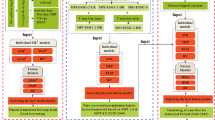Abstract
We thank Zhang et al. (Nat Resour Res, 2019. https://doi.org/10.1007/s11053-019-09512-6) for investigating the accuracy of artificial intelligence techniques in the prediction of drought in China. In the paper by Zhang et al. (2019), two data-driven models, namely artificial neural network and support vector machine, and autoregressive integrated moving average (ARIMA) model were established to estimate standardized precipitation evapotranspiration index (SPEI) values. In that paper, temperature and precipitation values were used as independent variables to predict SPEI. They stated that ARIMA models give higher accuracy in the prediction of SPEI values. Here, not only some of the missing points and deficiencies in the original publication, but also improvements that can be made in future studies, were mentioned. In addition, several points are introduced in order to make these points more clarified for potential readers.
Similar content being viewed by others
References
Aghelpour, P., Mohammadi, B., & Biazar, S. M. (2019). Long-term monthly average temperature forecasting in some climate types of Iran, using the models SARIMA, SVR, and SVR-FA. Theoretical and Applied Climatology,138(3–4), 1471–1480.
Altunkaynak, A., & Özger, M. (2016). Comparison of discrete and continuous wavelet multilayer perceptron methods for daily precipitation prediction. Journal of Hydrologic Engineering,21(7), 04016014.
Belayneh, A., Adamowski, J., Khalil, B., & Quilty, J. (2016). Coupling machine learning methods with wavelet transforms and the bootstrap and boosting ensemble approaches for drought prediction. Atmospheric Research,172–173, 37–47.
Danandeh Mehr, A., Kahya, E., & Özger, M. (2014). A gene-wavelet model for long lead time drought forecasting. Journal of Hydrology,517, 691–699.
Dickey, D. A., & Fuller, W. A. (1979). Distribution of the estimators for autoregressive time series with a unit root. Journal of the American Statistical Association,74, 427–431.
McKee, T. B., Doesken, N. J., & Kliest, J. (1993). The relationship of drought frequency and duration to time scales. In Proceedings of the 8th conference of applied climatology, 17–22 January, Anaheim, CA (pp. 179–183). Boston, MA: American Meteorological Society.
Moazenzadeh, R., & Mohammadi, B. (2019). Assessment of bio-inspired metaheuristic optimisation algorithms for estimating soil temperature. Geoderma,353, 152–171.
Moazenzadeh, R., Mohammadi, B., Shamshirband, S., & Chau, K. W. (2018). Coupling a firefly algorithm with support vector regression to predict evaporation in northern Iran. Engineering Applications of Computational Fluid Mechanics,12(1), 584–597.
Ozger, M., & Kabataş, M. B. (2015). Sediment load prediction by combined fuzzy logic-wavelet method. Journal of Hydroinformatics,17(6), 930–942.
Ozger, M., Mishra, A. K., & Singh, V. P. (2011). Estimating Palmer Drought Severity Index using a wavelet fuzzy logic model based on meteorological variables. International Journal of Climatology,31(13), 2021–2032.
Ozger, M., Mishra, A. K., & Singh, V. P. (2012). Long lead time drought forecasting using a wavelet and fuzzy logic combination model: A case study in Texas. Journal of Hydrometeorology,13, 284–297.
Palmer, W. C. (1968). Keeping track of crop moisture conditions, nationwide: The new crop moisture index. Weatherwise,21, 156–161.
Zhang, Y., Yang, H., Cui, H., & Chen, Q. (2019). Comparison of the ability of ARIMA, WNN and SVM models for drought forecasting in the Sanjiang Plain, China. Natural Resources Research. https://doi.org/10.1007/s11053-019-09512-6.
Author information
Authors and Affiliations
Corresponding author
Rights and permissions
About this article
Cite this article
Başakın, E.E., Ekmekcioğlu, Ö. Comment on “Comparison of the Ability of ARIMA, WNN and SVM Models for Drought Forecasting in the Sanjiang Plain, China” by Yuhu Zhang, Huirong Yang, Hengjian Cui, and Qiuhua Chen, in Natural Resources Research DOI: 10.1007/s11053-019-09512-6. Nat Resour Res 29, 1465–1467 (2020). https://doi.org/10.1007/s11053-020-09638-y
Received:
Accepted:
Published:
Issue Date:
DOI: https://doi.org/10.1007/s11053-020-09638-y




